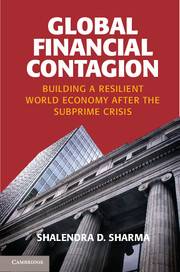Book contents
- Frontmatter
- Contents
- List of Figures
- List of Tables
- Acknowledgments
- Introduction
- One The United States
- Two The Bush and Obama Administrations’ Response
- Three From the U.S. to the European Crisis
- Four The Eurozone’s Sovereign-Debt Crisis
- Five Russia
- Six China
- Seven Japan, South Korea, and India
- Eight The Middle East amid the Global Financial Crisis
- Nine The Great Recession and the World’s Poorest
- Ten G-20 World
- Bibliography
- Index
Six - China
Crisis Management to Rebalancing
Published online by Cambridge University Press: 05 June 2014
- Frontmatter
- Contents
- List of Figures
- List of Tables
- Acknowledgments
- Introduction
- One The United States
- Two The Bush and Obama Administrations’ Response
- Three From the U.S. to the European Crisis
- Four The Eurozone’s Sovereign-Debt Crisis
- Five Russia
- Six China
- Seven Japan, South Korea, and India
- Eight The Middle East amid the Global Financial Crisis
- Nine The Great Recession and the World’s Poorest
- Ten G-20 World
- Bibliography
- Index
Summary
Even as the global economy was gripped in the throes of a financial crisis following the collapse of Lehman Brothers in September 2008, China was among a handful of economies that conspicuously remained an outlier. Not only was the Chinese economy booming – notching an impressive 9.3 percent growth in GDP in 2008, Beijing’s top priority was to dampen the inflationary pressures and prevent the economy from overheating. To many analysts, the starkly divergent trajectories of the world’s largest and second largest economies could be explained by a single fact: the Chinese economy had tangibly “decoupled” from the American economy. More specifically, the China-centered trade integration in Asia and the massive ability within China’s economy to generate a domestically driven demand meant that the Chinese economy’s business cycle had become less synchronized with that of the advanced economies, notably the United States and Western Europe. Predictably, this led observers to conclude that China was immune from an economic slowdown emanating from the United States and Europe.
To others, China’s immunity was due to the “cushion” Beijing enjoyed because of its substantial foreign-exchange reserves. Beijing’s holdings of U.S. Treasury debt skyrocketed from about $46 billion in 1998 to $587 billion by 2008. According to the U.S. Treasury, China’s investment in Treasury bonds totaled some $585 billion in September 2008, compared to Japan’s, which totaled $573.2 billion (Table 6.1). Moreover, in mid-2008, Beijing held the world’s largest cash reserve of roughly $2 trillion. This figure did not include an additional $800 billion in U.S. debt that Beijing purchased through third countries (such purchases are not recorded by the U.S. Treasury as being held by China). This meant that on the eve of the crisis China owned $1 out of every $10 of U.S. public debt. This made Beijing the largest foreign holder of U.S. government debt – indeed, the U.S. government’s leading foreign creditor – and the world’s leading creditor nation, while the United States became the world’s largest debtor.
- Type
- Chapter
- Information
- Global Financial ContagionBuilding a Resilient World Economy after the Subprime Crisis, pp. 204 - 233Publisher: Cambridge University PressPrint publication year: 2013



